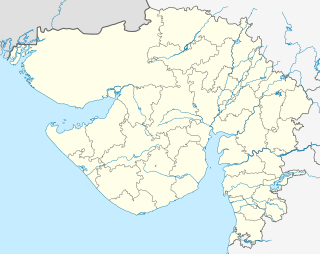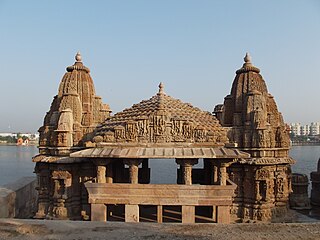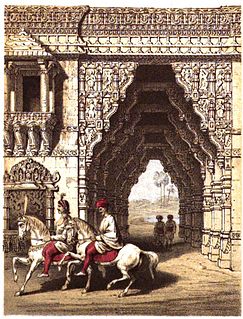
Dholka is a city and municipality in the Ahmedabad District of the Indian state of Gujarat. It is the headquarters of Dholka Taluka, and is 48 km by road via National Highway 8A southwest of the city of Ahmedabad. Dholka has an average elevation of 17 metres (56 ft).

Surendranagar is an administrative district in Saurashtra region of Gujarat state in India. It has a population of approximately 1.7 million people. Surendranagar city, along with the twin city of Wadhwan, has a total of 400,000 inhabitants, and is known as "Camp".

Palanpur is a city and a municipality of Banaskantha district in the Indian state of Gujarat. Palanpur is the administrative headquarters of the district.

Dabhoi is a town and a municipality in Vadodara district in the state of Gujarat, India.

Khedbrahma is a town and a taluka headquarter in Khedbrahma Taluka of Sabarkantha district, Gujarat, India. It is situated on the banks of Harnav river. The town is connected with mythological history and has been pilgrim site for centuries. The 11th century Brahma, Ambika and Pankhnath Mahadev temples are the oldest monuments of the town. The town has two old stepwells, the Brahma stepwell and the Aditi stepwell. It was under Parmaras, Chaulukyas and Pariharas before it came under Idar State in 13th century.

Viramgam is a town and former princely state, in the Ahmedabad district in the Indian state of Gujarat. Gateway Distriparks flagged off the first export train service from the newly-built inland container depot (ICD) at Viramgam.
Karna was an Indian king from the Chaulukya (Solanki) dynasty of Gujarat. He ruled the present-day Gujarat and surrounding areas, from his capital Anahilapataka.

Sahasralinga Tank or Sahasralinga Talav is a medieval artificial water tank in Patan, Gujarat, India. It was commissioned during Chaulukya (Solanki) rule, but now it is empty and in a ruined state. It is a Monument of National Importance protected by Archaeological Survey of India (N-GJ-161).

Damodar Kund(Gujarati: દામોદર કુંડ) is one of the sacred lakes as per Hindu beliefs, which is located at the foothills of Girnar hills, near Junagadh in Gujarat, India.
Stepwells are wells in which the water is reached by steps. They are most commonly found in western India especially Gujarat where over 120 such wells are reported. The origin of the stepwell may be traced to reservoirs of the cities of the Indus Valley Civilization such as Dholavira and Mohenjo-daro. The stepwells were constructed in the south western region of Gujarat around 600 AD. From there they spread north to Rajasthan and subsequently to north and west India. Construction activities accelerated during the 10th to 13th century during the Chaulukya and Vaghela periods. The construction of these stepwells hit its peak during the 11th to 16th century. The Muslim rulers of the 13th to 16th century did not disrupt the culture that was practiced in these stepwells and encouraged the building of stepwells. The wells lost their significance in the 19th century due to introduction of water pumps and pipe-systems.
Madana-Varman was a king of the Chandela dynasty of India. He succeeded his father Prithvi-Varman as the ruler of the Jejakabhukti region. He revived the Chandela glory by subduing the neighbouring kingdoms, and commissioned several tanks and temples.

Zinzuwada State, also spelled Jhinjhuvada or Jhinjhuwada is a town in Dasada Taluka of Surendranagar district, Gujarat, India. Zinzuwada 24c
Ra Mahipala III was a Chudasama king of Saurashtra region of western India who reigned from 1430 CE to 1451 CE. His capital was at Junagadh.
Ra Jayasimha II was a Chudasama king of Saurashtra region of western India who reigned from 1416 CE to 1430 CE. His capital was at Junagadh.
Ra Meliga, also known as Melaga or Maleka, was a Chudasama king of Saurashtra region of western India who reigned from 1400 CE to 1416 CE. He remove his capital from Vanthali back to Junagadh, from which place he expelled the thanadar appointed by Gujarat Sultan. Thus Gujarat Sultan Ahmad Shah I sent an army against Junagadh. He captured Vanthali and later Junagadh was besieged. Meliga left to a fort on Girnar hill which was inaccessible to the forces. So the forces left and placed two officers in Junagadh to collect tribute. Meliga died and was succeeded by his son Jayasimha II in 1416 CE.
Khengara was a Chudasama king of Saurashtra region of western India who reigned from 1331 CE to 1351 CE. His capital was at Junagadh.
Khengara was a Chudasama king of Saurashtra region of western India who reigned in the 12th century. His capital was at Junagadh. He was a contemporary of Jayasimha Siddharaja, the Chaulukya ruler of Anahilapataka. According to bardic tales, he was a son of Navaghana and had succeeded him.

Munsar Lake is water body constructed by Minaldevi, mother of Jayasimha Siddharaja, of Chaulukya dynasty. It was named as Mansavor but due to Indiscretion it’s widely know as Munsar. This lake is situated at Viramgam, near Ahmedabad.















